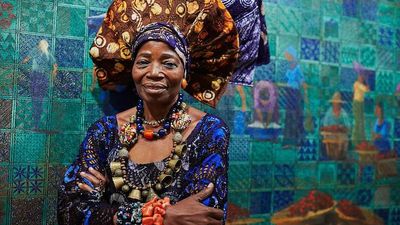Inside The Yoruba Textile Art Of Adire With Chief Nike Davies-Okundaye
Okayafrica speaks with renowned Nigerian visual artist and cultural icon Nike Davies-Okundaye about the Yoruba textile art of adire.
Chief Nike Davies-Okundaye is one of Nigeria's most renowned visual artists and cultural icons. Born in Ogidi, Kogi State, to an artistic family with a long history of textile craftsmanship, the 63-year-old designer and painter spurred the contemporary revival of traditional textile production in Nigeria. Each piece over the span of Davies-Okundaye's four-decade career has been imbued with her keen eye for dynamic composition and her vivid imagination which draws heavily on themes from both Yoruba folklore and her own life experiences.
In addition to her work as a cultural preservationist, Davies-Okudaye is a social entrepreneur, philanthropist and artistic matriarch. Since 1983, she has established museums, vocational arts training institutions, and textile design centers in Nigeria. Her work is currently on display in a retrospective at London's Gallery of African Art (through November 22nd). Okayafrica caught up with Davies-Okundaye at her workshop and cultural center in Osogbo, Nigeria, where she shared a few thoughts with us on Yoruba textile design and her work in the revitalization of the genre. Read the full Q&A below and click through the gallery above for a preview of the London exhibition and photos from our trip to Osogbo.
Okayafrica: Where does your process come from, traditionally and historically?
Nike Davies-Okundaye: Batik is a process which can be found all over the world. In Nigeria, traditionally, we practiced 'Adire' with cassava paste. I discovered batik by accident; while lighting a candle the melted wax fell on the adire eleko I was working on. After dyeing the fabric, I discovered the color was bright and I started to experiment from there.
OKA: How are you involved in keeping these traditional practices alive?
NDE: I have a workshop in Osogbo where people can train free of charge. I also have another workshop in Kogi where they practice traditional weaving and adire. At our Lagos branch we have school children, companies or just groups of friends that book sessions to learn the different textile processes. I try to keep the textile alive not only through batik and adire but by incorporating the textile patterns as part of my paintings. We have a lot of part and full time students from all over Nigeria from who come to the workshops to learn batik, reverse applique, quilting, embroidery and painting.
OKA: Why do you believe it's important to do so?
NDE: Our culture is dying off with young people no longer interested in learning and preserving culture and heritage. I'm passionate about preserving this culture and I do that through my arts and paintings. I also organize free workshops to teach young people how to make adire. Moreover, our cloths are the closest items to our skins and by extension to us which is why I try to use the Adire cloth to ensure that our culture and art is always around and with us. [Nowadays] young people are beginning to find traditional designs trendy, and are using them to make amazing designs from shoes, cloths, bags , earrings, bangles etc.
Davies-Okundaye also provided us with this handy stylesheet outlining some popular Adire patterns and meanings
OKA: Can you tell us some of the meanings of the various Yoruba symbols from the Adire cloth – you use them in your paintings as well. For example, one looks like a spiral, one is the "talking drum", and then there are flowers, the net or wire,etc?
NDE: Cowries represents money. It also represents power. Money is seen as a symbol of power. Our culture reveres and respects individuals who have money and these individuals seem to have automatic power over those who don't have as much as they do. Cassava leaves in the design represent life, and the talking drum isthe constellation of tradition.
OKA: Can you explain the basic processes for creating the batik-style T-shirts?*
NDE: Each one-of-a-kind batik shirt is created by heating wax on a hot plate, then applying the melted wax with a foam sponge on the shirts into the design of choice. Once the wax resist outline is completed, the shirts are immersed for 3-5 minutes into large pots containing natural dyes mixed with hydrosolvent and caustic soda. The process is then repeated until the desired effect is achieved.
*Shirts and scarves, crafted by Osogbo workshop leader Yomi Tiamiyu using traditional Yoruba methods are part of the Okayafrica Adire Collection. These one-of-a-kind items are walking, wearable art and come in highly limited quantities. Purchase batik shirts and indigo scarves in our online store.
